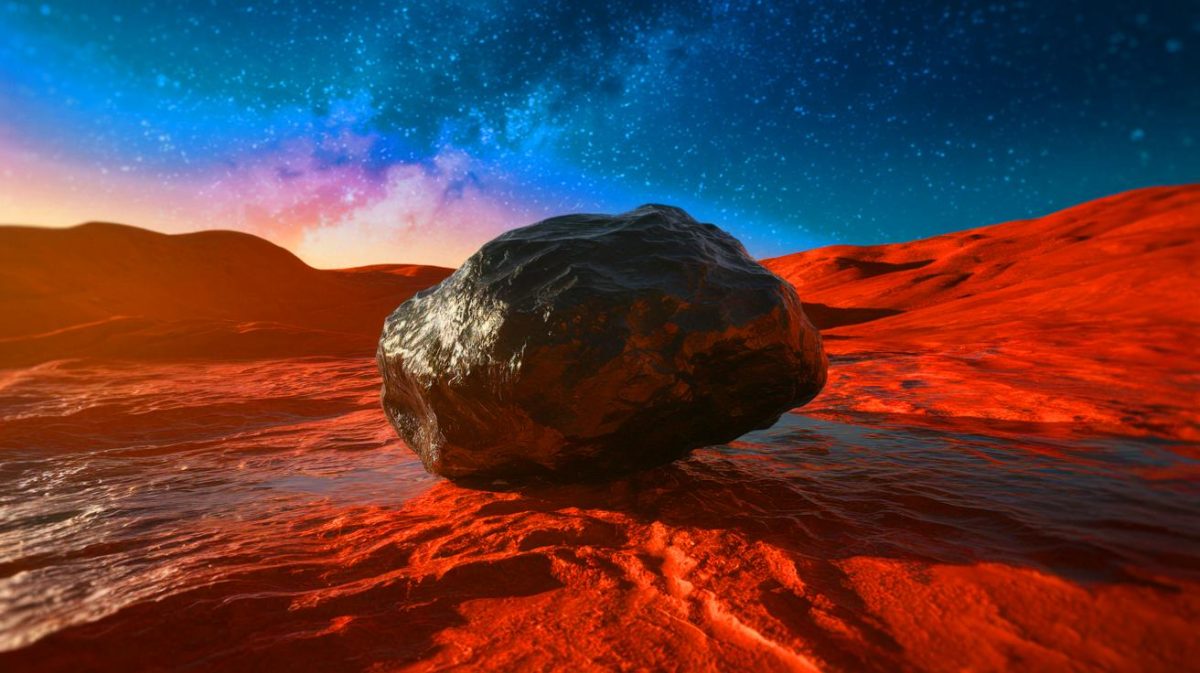| IN A NUTSHELL |
|
In what seemed like an ordinary black stone from the sky, the 2011 discovery of a meteorite in the Sahara Desert opened a window into the ancient secrets of Mars. This seemingly unremarkable rock, sold as a curiosity, held within it evidence of the Red Planet’s past, challenging our understanding of its history. Through meticulous analysis, scientists have unveiled astonishing details about this Martian fragment’s origins, offering profound insights into the conditions of early Mars.
A Unique Martian Rock Discovered in the Sahara Desert
In 2011, a mysterious black stone fell from the sky and was unearthed in the Western Sahara Desert by a group of Sahraouis. This meteorite, later known as Northwest Africa 7034, was quickly snapped up by an American collector in Morocco. For years, it sat in private hands as a mere curiosity, but its true identity as a piece of the Martian crust was eventually confirmed.
Despite its identification, it took scientists over a decade to reveal one of its most intriguing secrets. The rock’s journey from Mars to Earth didn’t just make it a collector’s item; it became a critical piece of planetary history. Its unique composition and age provide a rare glimpse into the Martian past, challenging researchers to rethink the planet’s geological timeline and its potential for harboring life.
“Black Beauty”: A Time Capsule from Mars
Officially named Northwest Africa 7034, and affectionately dubbed “Black Beauty”, this 11-ounce meteorite boasts a unique composition among known Martian samples. It contains minerals of vastly different ages, some ancient and some relatively young, yet its structure aligns with observations made by NASA’s rovers on Mars’s surface. These characteristics confirm that this rock was once part of Mars’s crust before being launched into space.
A recent analysis of a tiny zircon grain extracted from the meteorite unveiled a jaw-dropping age of 4.45 billion years. This relic dates back to the earliest chapters of Martian history, long before the planet transformed into the arid desert we know today. Unlike most Martian meteorites, which originate from more recent geological periods, NWA 7034 offers a precious window into the surface conditions of early Mars, providing invaluable data for scientists researching the planet’s evolution.
Evidence of Hot Water on Mars
Black Beauty is remarkable for its high water content, up to ten times more than other known Martian meteorites. Scientists already knew that the rock had interacted with water on Mars during its formation. However, advanced microscopy techniques have now revealed a crucial element: the presence of tiny magnetite inclusions (an iron oxide), trapped within the zircon.
This discovery suggests that the zircon crystallized in a hydrothermal environment, meaning in the presence of high-temperature water and under oxidizing conditions. Furthermore, the magnetite is located in areas of the zircon that are untouched by radiation effects, indicating it formed simultaneously with the zircon, rather than from later geological processes. Essentially, 4.45 billion years ago, during Mars’s pre-Noachian period, hot water sources existed in the Martian crust. Black Beauty thus serves as direct evidence that water was present on Mars from its early ages, reshaping our understanding of the planet’s capacity to support life.
An Environment Conducive to Life?
This remarkable discovery bolsters the theory that Mars may have possessed conditions favorable for the emergence of life, at least in microbial form, very early in its history. While the question of whether life ever existed on Mars or could have been transported to Earth via meteorites remains unanswered, the wealth of information obtained from a meteorite discovered in 2011 underscores the crucial importance of Martian samples. Future missions by NASA and China aim to bring more of these invaluable samples back to Earth.
As we continue to study these ancient relics from Mars, we are left pondering the mysteries that still lie beneath its dusty surface. What other secrets might the Red Planet hold, waiting for us to uncover in our quest to understand our place in the cosmos?
Did you like it? 4.4/5 (30)








Wow, that’s some out of this world news! 🌌
Fascinating discovery! How does this impact our search for life on Mars?
So, basically Mars was a giant hot tub 4.45 billion years ago? 🛁😂
Can we expect more meteorites like Black Beauty to be found?
Thanks for sharing this amazing discovery! It feels like we’re getting closer to proving life on Mars. 👽
Is there any chance that the findings might be wrong? Science is always changing!